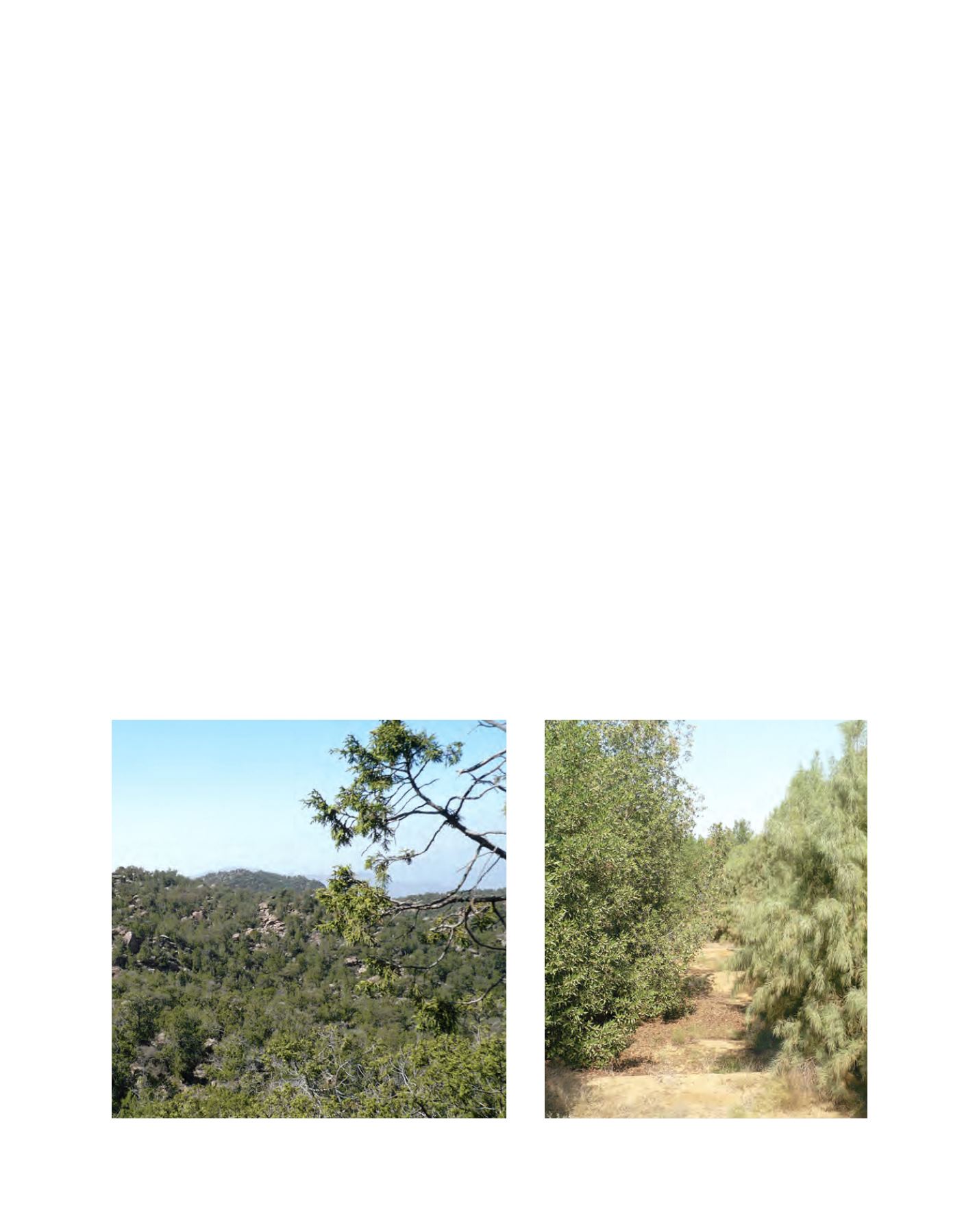

[
] 286
eventual decline. Furthermore, the substantial increase
in income and rapid demographic inflation has led to
fast, unmanaged urban expansion into forested areas,
causing significant shrinking of the natural vegetal
cover, especially in the Sarawat Mountains.
Forest and wood lands in KSA are currently subject
to rigorous stress conditions, causing degradation and
shrinking. Such stress is the result of anthropogenic
factors, including fuel wood cutting, overgrazing, urban
expansion, wildfires and misuse of parks and picnic areas,
in addition to harsh environmental conditions (low rain-
fall averaging 106 mm per year, hot temperatures, high
evaporation rate, severe droughts and poor soils).
For more than three decades now, the juniper forests
of the Kingdom of Saudi Arabia have been exhibiting
symptoms of widespread decline, including unhealthy
trees, poor production of berries and cones, top dieback,
mortality of scattered individual trees and entire stand
mortality. The dieback and decline of juniper have been
attributed to a range of factors, including localized climate
changes, water stress resulting from poor water harvesting
due to damaged and abandoned terraces, secondary insect
pests and pathogens, heavy pressure exerted by tourists in
national parks, soil compaction, road network expansion,
urban development and lack of management plans.
7
Forestry policy and intervention
To stop forest degradation and set the conditions for
sustainability, the Government of KSA took several steps,
including adopting the Saudi Forest and Range Act and
by-laws (1978) and updating them in 2005 to secure
forest tenure, assure protection and encourage sustain-
able development. A National Forest Strategy and Action
ing 11 per cent of the total population of 27 million.
4
A recent study
conducted by the Ministry of Agriculture in collaboration with the
King Abdulaziz City for Science and Technology and King Saud
University
5
showed that among a surveyed sample of the population
living within the three provinces, a proportion of 92 per cent use
the forest for recreation purposes, 76 per cent practise agricultural
activities, 32 per cent use it for livestock grazing, 16 per cent harvest
forest firewood and 14 per cent own beehives or grazing land in the
forest. In addition, 2 per cent collect forest medicinal and aromatic
plants and products.
Reliance of the local populations on the forest in these areas was
almost total in past centuries as it provided them with all their needs,
including air, food, fibre, shelter, water and medicine. However,
during the last half century, important changes have occurred as
a result of the mutation of the Saudi economy generated by the oil
boom, reducing direct reliance on the forest as a source of livelihood
and increasing its use for recreation. This has led to the creation
of 16 wildlife reserves and 14 national parks in various parts of
the country, among which, two reserves (Raida and Shada Alaala)
and three national parks (Assir and Al-Baha, Taif) are located in
the mountain forests. These parks attract more than five million
summer visitors annually, generating important economic activity
and creating jobs, but also causing a great deal of soil compaction,
tree injury and pollution.
Agriculture has been abandoned to a great extent in the mountain
forests in favour of Government jobs and other more lucrative activi-
ties.
6
Terraces, which are scattered all over the mountain slopes,
supported the main agricultural activities in the past. Currently
most of them are abandoned or no longer maintained, leading to
soil erosion, soil crusting and subsequent drastic soil disturbances.
Throughout the juniper ecosystem an important proportion of rain-
fall now runs off instead of infiltrating or percolating into the soil,
causing moisture stress for the trees and leading to low vigour and
Juniper ecosystem in Assir
Conocarpus and Tamarix green belts to stop sand advance
Image: Ministry of Agriculture, KSA
Image: Ministry of Agriculture, KSA
















